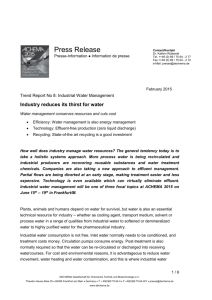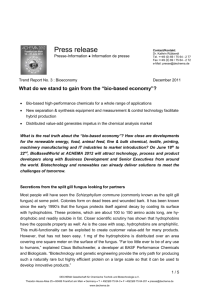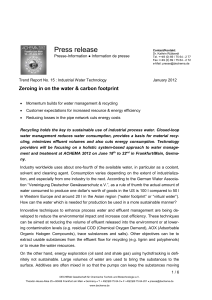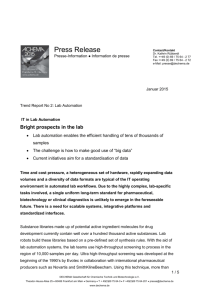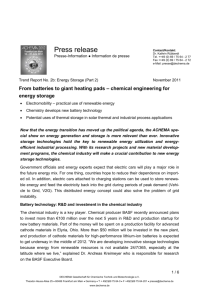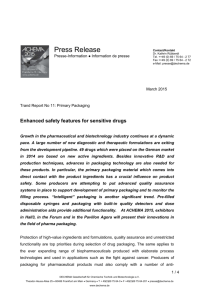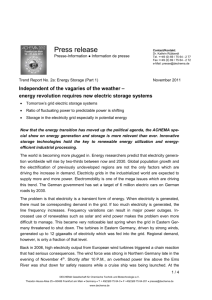doc - Achema
advertisement
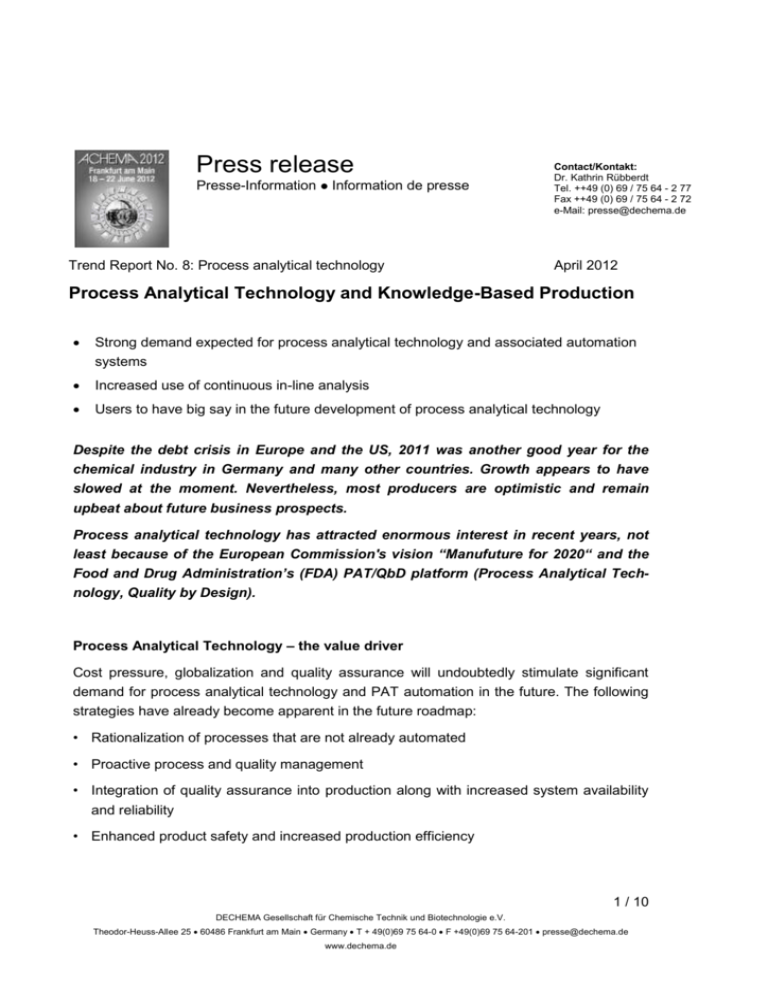
Press release Presse-Information Information de presse Trend Report No. 8: Process analytical technology Contact/Kontakt: Dr. Kathrin Rübberdt Tel. ++49 (0) 69 / 75 64 - 2 77 Fax ++49 (0) 69 / 75 64 - 2 72 e-Mail: presse@dechema.de April 2012 Process Analytical Technology and Knowledge-Based Production Strong demand expected for process analytical technology and associated automation systems Increased use of continuous in-line analysis Users to have big say in the future development of process analytical technology Despite the debt crisis in Europe and the US, 2011 was another good year for the chemical industry in Germany and many other countries. Growth appears to have slowed at the moment. Nevertheless, most producers are optimistic and remain upbeat about future business prospects. Process analytical technology has attracted enormous interest in recent years, not least because of the European Commission's vision “Manufuture for 2020“ and the Food and Drug Administration’s (FDA) PAT/QbD platform (Process Analytical Technology, Quality by Design). Process Analytical Technology – the value driver Cost pressure, globalization and quality assurance will undoubtedly stimulate significant demand for process analytical technology and PAT automation in the future. The following strategies have already become apparent in the future roadmap: • Rationalization of processes that are not already automated • Proactive process and quality management • Integration of quality assurance into production along with increased system availability and reliability • Enhanced product safety and increased production efficiency 1 / 10 DECHEMA Gesellschaft für Chemische Technik und Biotechnologie e.V. Theodor-Heuss-Allee 25 60486 Frankfurt am Main Germany T + 49(0)69 75 64-0 F +49(0)69 75 64-201 presse@dechema.de www.dechema.de In a recent survey published in Pharmaceutical Technology magazine, a number of companies gave their assessment of process analytical technology (PAT) at the company and in production based on the following criteria: Fig. 1: Survey on the benefit of process analytical technology in the questioned companies So the role of PAT is essentially to promote an understanding of the process at the basic mechanistic level and introduce knowledge-based production. In January 2011, the FDA published its Guidance for Industry on process validation to help achieve this goal. The Guideline recommends that producers should achieve an understanding of the process based on first principles during Stage 1 (Process Design) and develop a process control strategy during the development phase. In Stage 2 (Process Qualification), qualification and verification should be carried out on the process in order to ensure reproducible results. Finally during Stage 3 (Continued Process Verification), in-line control, and spectroscopic techniques in particular, help manage and continually improve the process. When various companies were asked why they do not use PAT, they cited the following reasons: 2 / 10 DECHEMA Gesellschaft für Chemische Technik und Biotechnologie e.V. Theodor-Heuss-Allee 25 60486 Frankfurt am Main Germany T + 49(0)69 75 64-0 F +49(0)69 75 64-201 presse@dechema.de www.dechema.de Fig. 2: “Why don’t you use PAT in your company?” So a major reason for rejecting PAT is an unwillingness to invest the necessary human and financial resources. Arguing that insufficient financial returns make PAT unattractive is surprising. This assertion stands in contrast to statements by the chemical industry that PAT significantly increases ROI in most cases. If lifecycle costs are used as the yardstick rather than up-front costs only, PAT looks like a good investment. Surveys indicate that turnover in the process analytical technology industry is likely to increase by 35 % by 2015, an unmistakable sign that rapid growth can be expected over the next few years. Standardization is the key to broad-based acceptance Standardization of process analytical instrumentation used in industrial environments and all issues relating to comparability, performance and functionality are addressed at the international level by International Electrotechnical Commission‘s (IEC) Technical Committee TC 65B “Measurement and control devices”. This includes measurement and analysis equipment, actuators and PLCs. WG14 “Analyzing equipment” looks specifically at process analytical instrumentation. At the national level, Committee K 966 at DKE (German Commission for Electrical, Electronic & Information Technologies) addresses quantitative analysis equipment for industry and the environment. K 966 mirrors IEC TC 65B in the national context. Its range of responsibilities includes generation of standards for instrumentation, systems and accessories for quantitative analysis of gases, liquids and solids for stationary and non-stationary use in labs, industrial processes, environmental protection, etc. The 3 / 10 DECHEMA Gesellschaft für Chemische Technik und Biotechnologie e.V. Theodor-Heuss-Allee 25 60486 Frankfurt am Main Germany T + 49(0)69 75 64-0 F +49(0)69 75 64-201 presse@dechema.de www.dechema.de Committee is actively involved in several current gas analyzer projects (IEC 61207-1 Expression of Performance of gas analyzers – Part 1: General, IEC 61207-7 Tunable laser gas analyzers and IEC 65B/751/NP Expression of performance of fluorometric oxygen analyzers in liquid media). Subcommittee DKE/UK 966.1 is developing standards for production, safety, workplace atmosphere, operating characteristics and testing of gas detectors. This equipment is designed mainly to detect or determine the concentrations of flammable or toxic gas and vapor or oxygen. As a user interest group which operates in the pre-normative environment, NAMUR has been addressing various issues relating to automation technology for more than 60 years. The organization also issues recommendations which are recognized by the international community. The goal is to promote the sharing of information on analytical techniques and instrumentation, maintain communications with testing bodies and government agencies and represent the interests of users in their relationship with manufacturers. NAMUR Work Area 3 deals with measurement (sensor and actuator technology). AK 3.6 “Analytical Measurement” defines quality, safety, availability, lifecycle cost and functional requirements for analytical instrumentation from the user perspective. A joint working group made up of members from NAMUR and the VDI/VDE instrumentation and automation association GMA recently drew up the “Process Sensors 2015+” technology roadmap to define development goals for process sensors. Turning data into knowledge There are a number of possible approaches to knowledge-based process development and production. Instrument-based process analytical technology expands the traditional spectrum of variables (e.g. temperature and pressure) to optimize control of sophisticated production processes. The progress of a reaction or process can be controlled most effectively when this information is directly accessible. Besides the continued technological development of process analytical technology, another goal is to increase confidence in the complex technology. This is an issue which researchers, equipment manufacturers and users will have to address together. Equipment, process and approval data that already exists in plants and labs provides another route to knowledge-based production. This data is currently not being fully exploited to achieve a thorough understanding of production. The goal in this instance is to deploy information management systems in lab, production and company environments for structured acquisition of data which transcends the process chain. Statistical analysis can then identify possible ways of improving the process. Analytical information, set points and device messages functioning as soft sensors are already being evaluated as a combined data 4 / 10 DECHEMA Gesellschaft für Chemische Technik und Biotechnologie e.V. Theodor-Heuss-Allee 25 60486 Frankfurt am Main Germany T + 49(0)69 75 64-0 F +49(0)69 75 64-201 presse@dechema.de www.dechema.de set in some initial process control applications without the need for additional software investment. In reality, the data available in a production environment tends to come from a variety of data sources. These data sources are often part of structures that have evolved over time. Different aspects played a primary role in their implementation. There is little or no interconnectivity between the various sources, but the data is ideally suited as input to a database. Electronic storage of the available data is a basic prerequisite. In most instances, production and/or lab information management systems (PIMS and LIMS) already exist which, when used properly, provide a major insight into how the process works. PAT sensors: a blind analyzer isn’t much help State-of-the-art sensors go hand in hand with in-line analytical technology. They are deployed wherever possible, because complex extraction of samples which must then be taken to the analyzer is both cumbersome and error prone. The term “sensor” in this context does not refer to an elementary sensor but rather to probes which feature specific configurations or combinations of complex sensors (the term “electrodes” is used in electrochemical engineering). For many years, the emphasis has been more on cautious improvement of existing methodologies rather than development of completely new detection techniques. However to an increasing extent, optical techniques such as chemiluminescence are replacing conventional amperometry, particularly in oxygen determination applications despite the fact that versions suitable for explosion hazard zones in the process are not currently available. In the pharmaceutical industry, chemiluminescence spots are used as disposables in potentiometric applications (pH value). Although the detection and working range is severely restricted compared to conventional glass electrodes, the spots are adequate for bag (single-use) applications. Calibration and adjustment without interfering with the process remains an unresolved challenge that is frequently associated with in-line analytical technology. There are two possible approaches to the problem. One answer is to transfer more and more intelligence to the sensor. Digital sensors now provide calibration data and diagnostics. In many instances, sensors which have been pre-calibrated under lab conditions can be used directly in the process. Otherwise, retractable housings must be deployed to facilitate automatic insitu cleaning and calibration of the sensors. This becomes necessary if the process medium is particularly contaminated, abrasive or deposit-forming. The best analyzer is not much help if it is working blind. 5 / 10 DECHEMA Gesellschaft für Chemische Technik und Biotechnologie e.V. Theodor-Heuss-Allee 25 60486 Frankfurt am Main Germany T + 49(0)69 75 64-0 F +49(0)69 75 64-201 presse@dechema.de www.dechema.de Users determine the future development path of PAT Chemical industry: knowledge-based production at all levels From the process automation and field technology perspective, the dominant process variables in the chemical industry continue to be physical parameters such as temperature, pressure, volume flow (streams/metering/fill level), rotational speed and energy variables including power and heat generation. Developments in industrial process analytical technology observed over the years (e.g. integration into the process control system, fieldbus technology, miniaturization, portability, explosion protection and more recently SIL (Safety Integrity Level, IEC 61508/61511)) are ongoing trends. Lab techniques which have evolved into online methods are gradually finding their way into process analytical technology. Besides established chromatographic and spectroscopic methodologies such as gas chromatography (GC), Near Infrared (NIR) spectroscopy and UV/VIS spectroscopy, this also applies to mass spectrometry, ultrasonic technology and Raman and microwave spectroscopy. Even analytical techniques which used to be regarded as exotic such as ion mobility spectrometry and cavity ring-down spectroscopy are making their way into today’s online production environment. The use of NIR spectroscopy in particular is becoming more widespread in the chemical industry. Applications range from incoming inspection and production monitoring to final inspection of the end product. The lack of a standardized data format along with complicated calibration transfer between instruments made by different manufacturers and even between different instruments made by the same manufacturer continue to be an annoyance that makes it necessary for users to invest a lot of time and money. Agreement by equipment manufacturers on data format standards and equipment control systems would be very welcome. Over the coming years, the application range for analytical technology will continue to expand into processes which are upstream and downstream from the actual chemical reaction. Increasing use of renewable bio-based feedstock, which is subject to significant natural variation, will tend to accelerate that trend. As a result, PAT will be based on an increasingly holistic approach to the chemical process. There is also an urgent need to develop techniques for taking representative samples and adequately preparing the samples for process analytical equipment. The results provided by process analytical technology are being used more and more for direct process control. Improvements in trace and ultra-trace analysis techniques will be needed in response to more stringent regulatory emissions standards, greater environmental awareness in the chemical industry and ever more demanding product quality expectations. The lab tech6 / 10 DECHEMA Gesellschaft für Chemische Technik und Biotechnologie e.V. Theodor-Heuss-Allee 25 60486 Frankfurt am Main Germany T + 49(0)69 75 64-0 F +49(0)69 75 64-201 presse@dechema.de www.dechema.de niques are very well established and are being constantly improved, but process suitability is still rudimentary for the most part. Miniaturized analytical equipment will be needed to keep pace with the ongoing development of modular reactors and small-scale reactors which offer enhanced flexibility. Advances in sensor technology developed for biotechnology, environmental or medical applications could find their way into the chemical industry. Chemometric data analysis is becoming more widespread in the chemical industry which has traditionally been dominated by a synthetic and process engineering based approach. Soft sensors are used for online comparison of ongoing reactions with historical data, for predicting the final properties of a reaction product and even for assessing individual application characteristics. Pharmaceutical industry: from reactive to proactive The FDA PAT initiative and guideline Q8 issued by ICH (The International Conference on Harmonisation of Technical Requirements for Registration of Pharmaceuticals for Human Use) outline a possible approach to enabling production improvements in a design space (i.e. an allowable range of critical parameters) without the need for submitting a change notification, the goal being to deliver products which are as effective and safe as possible. The analytical techniques which delineate the design space based on sound scientific principles are validated rather than the process itself. What this means is that quality can be based on process design and control provided that all relevant information is available and is interpreted correctly. There must be a clear understanding of the dependencies between product quality and the production process. The PAT initiative has been the subject of intense discussion, and it has stimulated intensified research activities and a new awareness in the regulatory world. If the PAT concept were to be rigorously applied, there would be no real need for release analysis or quality control on the manufactured products. The methodology offers the unique opportunity to implement Real Time Release (RTR). Costs go down because the release logistics and analytical overhead are no longer needed. However, the new approach represents a paradigm shift, and from the perspective of the people who are ultimately responsible in production this requires a high level of trust. Biotechnology and medical technology: the sensor multi-modularity principle Implementation of the PAT/QbD concept is particularly difficult in the biotechnology and biopharmaceutical industries. Substance concentrations are low and water which acts as a matrix interferes with optical analysis at many important wavelengths. Depending on cell 7 / 10 DECHEMA Gesellschaft für Chemische Technik und Biotechnologie e.V. Theodor-Heuss-Allee 25 60486 Frankfurt am Main Germany T + 49(0)69 75 64-0 F +49(0)69 75 64-201 presse@dechema.de www.dechema.de size and aggregation, the light is scattered and the length of the optical path changes continually when photonic analysis is used, often preventing reliable quantitative assessment. Keeping production fully under control depends on an understanding of the chemical, biochemical and physical processes involved as well as on the timely availability (in-line or online analytical systems) of parameters which can be correlated with the chemical, biochemical and physical processes. However, these product properties are seldom detectable with a single sensor, creating the need for a multi-modal approach. The term multi-modal spectroscopy refers to a combination of information collected in different wavelength bands or a combination of information collected at the same wavelength but using different detection geometries. The biotechnology process industry operates in a highly dynamic and competitive global market. The development, establishment and provision of innovative solutions are crucial to the future competitiveness of Germany as a manufacturing base. The goal has to be to develop and deploy innovative sensor technology as well as optimal process management tools which are based on that technology for products and processes in the life science industry. As is the case in other segments of production, resource efficiency, process reliability, sustainability and process variability are key considerations in bioprocessing. The aim is to tune the biotechnology process so that it meets the economic and ecological requirements profile. Photonic solutions will have a key role to play, because they support non-contact, nondestructive, in-line/online control of critical process parameters, making a substantial contribution to optimized efficiency, product quality and safety in the production process. The techniques described above provide a wealth of spectroscopic data. Used in combination with process data (i.e. temperature, etc.), they describe a process trajectory which is essentially a fingerprint of the bio-process over time. A trajectory reveals the intrinsic signature of the process and consists of the major elements which describe the process. State-of-the-art techniques such as Multivariate Curve Resolution (MCR) and Science-Based Calibration (SBC) add an additional scientific dimension to the analysis process. Biomarker research holds the key to early medical diagnosis, screening and preventive medicine. Besides their importance for medical diagnostics, biomarkers play a fundamental role in personalized medicine. They can be used to track and quantify the progress of therapy and even make it possible to directly link diagnostics and therapy (theragnostics). Development of suitable labels is often a difficult and protracted process. Labels are normally not endogenous substances, and as a result they must be validated and approved to meet regulatory requirements. That is why the development of marker-free techniques based on photonic technology (spectroscopy) is expected to play a major role in the future. 8 / 10 DECHEMA Gesellschaft für Chemische Technik und Biotechnologie e.V. Theodor-Heuss-Allee 25 60486 Frankfurt am Main Germany T + 49(0)69 75 64-0 F +49(0)69 75 64-201 presse@dechema.de www.dechema.de In addition, the approval process is too time-consuming at the moment. The regulations need to be simplified in order to speed up the process. Food and animal feed industry: the importance of automation Compared to the chemical and pharmaceutical industry and other branches of production, the level of automation in the food and animal feed industry is relatively low. It would appear that cost pressure, globalization and quality assurance are factors which will make the food and animal feed industry an attractive future market for the automation industry. A study conducted by ZVEI (German Electrical and Electronic Manufacturers‘ Association) and the Institute for Future Studies and Technology Assessment (Integrated Technology Roadmap AUTOMATION 2015+, 2006) identified the following future automation needs: • Rationalization of processes that are not already automated • Proactive process and quality management – integration of quality assurance into production and increased system availability and reliability • Tracking and Tracing – enhanced food safety and less food spoilage Once again, optical techniques will have a major role to play. Development of sensors to detect microorganisms along with development of solutions for optimized cleaning and wireless sensor networks presents an additional set of challenges. The future competitiveness of production: research and continuing education are the key Under the umbrella of Agenda Photonics 2020, the German Federal Ministry of Education and Research put forward a vision which outlines how photonic techniques could be integrated into production automation. The fact that research in this field is heavily technology driven at the moment and involves highly complex issues is one major obstacle. Conditions have to be put in place which create a supportive framework for the paradigm shift from the current technology push approach to application pull and encourage close user involvement. Barriers between the various disciplines will have to be eliminated. The transdisciplinary approach will have to be reflected to a greater extent in the educational curriculum and organizational structures. The general approach must be to generate fascination on the part of students for the complexities involved and set up advanced training programs. The role of process analytical technology is to bring the different cultures together. The lack of qualified personnel makes realization of this goal particularly difficult. Although insular solutions exist at some universities and educational institutions in Germany and the rest of Europe, they are not able to provide the breadth which is necessary for technologies that involve multiple disciplines. According to management consultants A.T. Kearney, the lack of 9 / 10 DECHEMA Gesellschaft für Chemische Technik und Biotechnologie e.V. Theodor-Heuss-Allee 25 60486 Frankfurt am Main Germany T + 49(0)69 75 64-0 F +49(0)69 75 64-201 presse@dechema.de www.dechema.de qualified staff may soon begin to stifle growth in the German chemical industry. The study also suggests that despite a drop in employment numbers, as many as 30,000 job vacancies may remain unfilled by 2030, placing growth and innovation capabilities at risk. Given this scenario, the only way forward is to develop a new educational and training strategy for industry and increase the level of cooperation between universities and the industrial sector. It is vital to foster the trialogue between universities, equipment manufacturers and end users and embed this knowledge into every facet of day-to-day operations. Authors: Prof. Dr. Rudolf Kessler (Hochschule Reutlingen), Dr. habil. Wolf-Dieter Hergeth (Wacker Chemie), Dr. habil. Michael Maiwald (BAM), Dr. Dirk Steinmüller (Knick). All four authors are members of the Joint Working Group "Process Analysis" of DECHEMA and GDCh. www.achema.de (The trend reports are compiled by specialized international journalists. DECHEMA is not liable for incomplete or inaccurate information.) 10 / 10 DECHEMA Gesellschaft für Chemische Technik und Biotechnologie e.V. Theodor-Heuss-Allee 25 60486 Frankfurt am Main Germany T + 49(0)69 75 64-0 F +49(0)69 75 64-201 presse@dechema.de www.dechema.de
